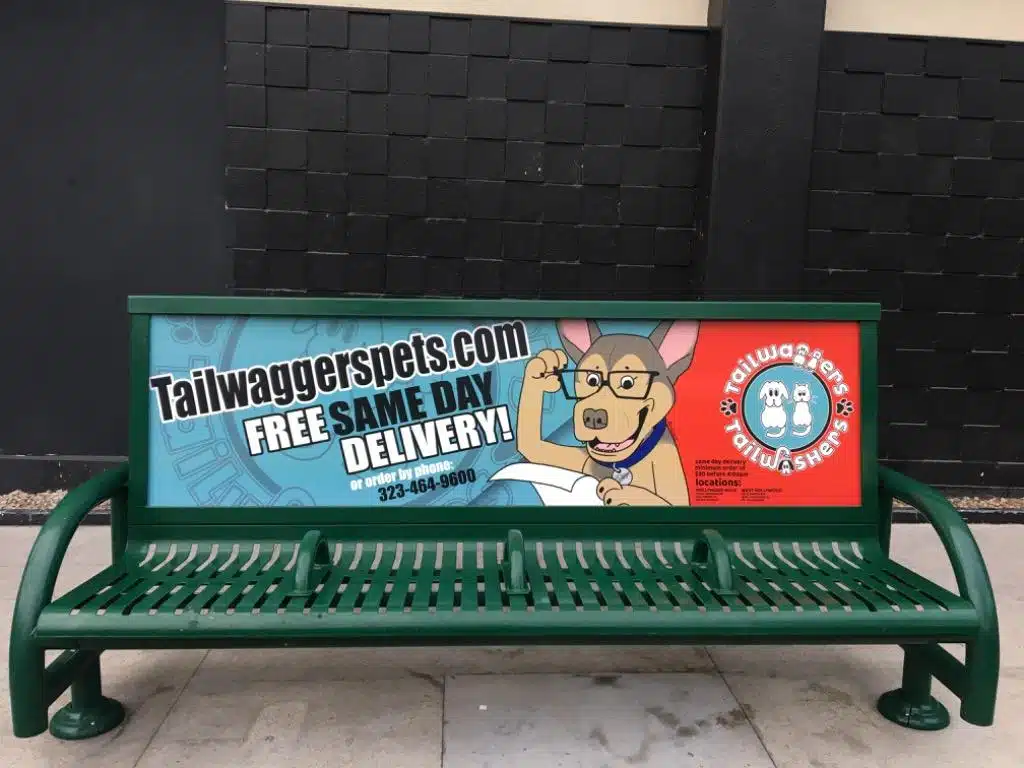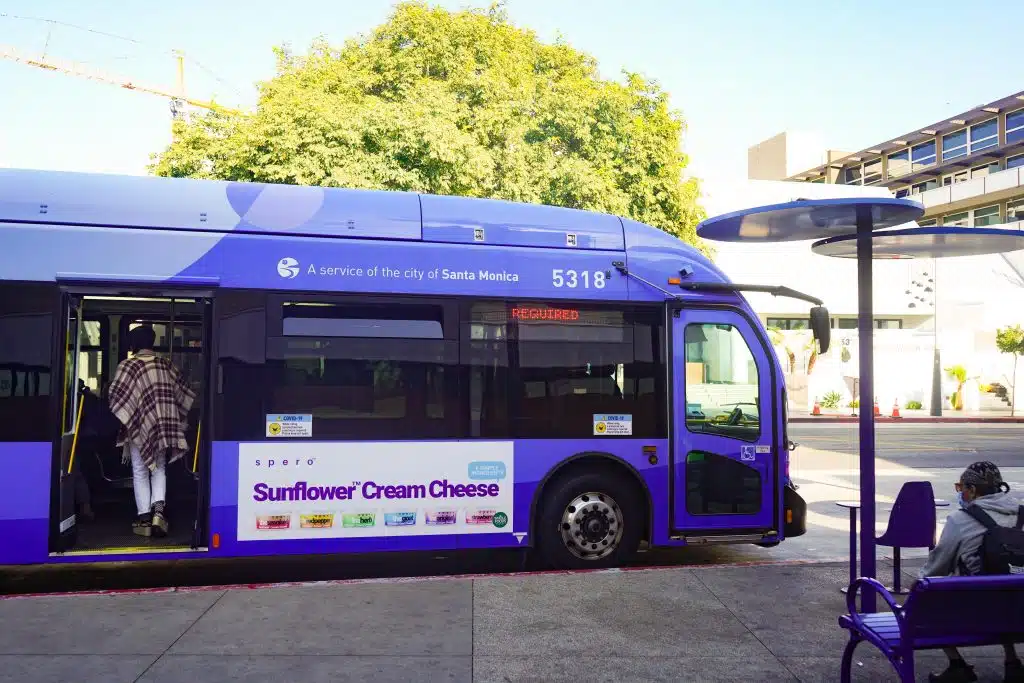Street furniture advertising encompasses all forms of out of home advertising located on street level. It includes ads on transit shelters, bus benches and kiosks as well as in-storage signage and even panels in convenience stores or shopping malls.
In fact, just about anything outside falls under the street furniture umbrella. Advertisers use it in suburban and urban areas. This form of out of home advertising provides a way to dominate a small space and draw even more attention to a product or service. For instance, an advertiser might have advertising on a bus bench, transit shelter and phone kiosk for a 360-degree domination.
What Is Street Furniture Advertising?
Street furniture advertising, sometimes referred to as street-level urban media, appears at eye level for easy viewing when you walk around the street, wait for transportation, or wander through a store or mall. It offers a high-impact way to connect with pedestrians and commuters alike.

Why Use Street Furniture Advertising?
Street Furniture Advertising offers unique advantages that make it a valuable part of any outdoor marketing strategy. Here are its three main benefits:
- It’s inexpensive: Street-level ads are among the most cost-effective options available. You can buy this type of advertising for much less than many other forms, including digital and traditional media. Even within the relatively low-cost outdoor advertising ecosystem, it’s exceptionally affordable. For instance, the average CPM for transit shelter advertising is less than $3.50—a fraction of the CPM for television advertising.
- It’s effective: Dwell time while waiting for a bus, shopping, or simply passing by is high, providing ample opportunity for pedestrians and commuters to notice and absorb your ads. Whether for minutes at a bus stop or while walking to a destination, street furniture ads ensure strong visibility and engagement with your brand.
- It’s evolving: Recent advances in
digital signage have introduced innovative formats for street furniture advertising. Digital displays open up exciting avenues for creativity, allowing advertisers to deploy interactive or dynamic ads that capture attention. For example, we’ve seen and executed fun ideas like lights that activate to promote a new bulb or soccer goal installations around shelters to advertise upcoming games. For more inspiration, explore our
Outdoor Advertising Guide.
Street Furniture Advertising Examples
Street furniture advertising examples include anything you can see on the street. From kiosks to wherever you sit to wait for a bus to food carts to streetlight poles, anything with a surface is fair game for street furniture advertising. It’s available in NYC, LA and every major market.
The most desirable locations have the greatest visibility. The more people who see your advertisements, the better. Here are a few of our favorite types of street furniture advertising.
How Much Does Bus Bench Advertising Cost?
The general range in price for bus bench advertising is $150-$300 per unit for four weeks. You may get a discount from a vendor if you make a large purchase or lock in for a longer timeframe.
Locations for Bus Bench Advertising
The ideal location varies from city to city, based on who the brand wants to target. The best bus bench advertising places in Los Angeles and New York allow advertisers to target by demographic. They might want to reach Hispanic households, for instance, with advertising in Spanish, so we can find a neighborhood that meets those demographic demands.
What Is Kiosk Advertising?
The kiosk advertising meaning includes freestanding displays that come in a range of sizes and shapes. The displays provide a place for advertising to remain long-term, protected inside the kiosk. Digital kiosks have also gained popularity. Kiosks are located in malls, airports, stadiums, transit stations, stores and more.
Kiosks enjoy great visibility, and they often sit in a busy location where lots of people are packed in. Think about the last time you walked through an outdoor mall — you can probably remember at least five kiosk messages. It’s difficult to walk past a kiosk without noticing.
How Much Does Kiosk Advertising Cost?
Kiosk advertising costs a bit more than bus bench advertising at $300-$400 per unit for four weeks. Costs may vary for digital kiosks.
Transit Shelter Advertising
Transit shelter ads, also often referred to as bus shelter advertising, appear on the sides of a transit shelter where commuters wait to catch the bus. They appear on a single panel or more, on top of glass, backlit frames, where commuters can also see them.
Bus shelter advertising effectiveness rates rank high, which is why many advertisers seek it out. They offer impressive frequency, since many of the people who see the ads visit the transit shelter every day for public transportation. Plus, passersby can see transit shelter ads all day, every day.

Bus Shelter Advertising Cost
They cost about $2,500 to $3,500 in New York City and a bit less in LA — $1,500 to $2,500. For that, you get 500 to 900 shelters, depending on the market where you buy. Bus shelters sit at street level, and it’s easier to track impressions than for a bus.
Shelters usually have a minimum buy of 10, but you could do a single one in special cases. Some advertisers trick out a shelter in hopes of drawing media coverage. For instance, IKEA famously replaced the usual bus shelter “furniture” with furniture of its own, adding a nice couch, pillows and curtains from the store, inviting bus riders to sit in comfort.
But generally speaking, the more reach and frequency you have, the better off you’ll be. Bus advertising is different from some other forms of advertising in that way. Market saturation is the game.
Street Light Pole Advertising
Street light pole advertising is available in big and small markets across the country. It includes banners that hang from or on either side of street poles and is often used to raise awareness of a special occasion or event, such as an upcoming parade. Double-sided and digital ads are available, too.
Advertising on Phone Kiosks
People don’t use payphones to make phone calls anymore, but phone kiosks do still exist. What happened to them after everyone got cellphones? The kiosks became the perfect vehicle for advertising.
The sides of the kiosk provide fantastic visibility for signage. You can duplicate the message across lots of kiosks in the same area to go for a domination approach.
How Big Are Phone Kiosk Ads?
The standard size of most phone kiosk advertising is 48 to 50 inches tall and 24 to 26 inches wide.
Food Cart Toppers
With many people choosing outdoor dining amidst the COVID-19 pandemic, there’s arguably never been a better time to put an advertising message on a food cart. Adding a message to the top of a cart will reach people on the streets and standing in line to get their food.
Any category can advertise on a food cart topper. You can find digital options in bigger markets like LA and NYC, too, allowing for easier swapping out of the message.
Street furniture is a smart way to get your message out and stand out in a crowded outdoor market. If you’re interested in learning more about your options, contact DASH TWO today.

